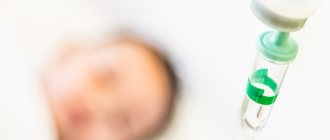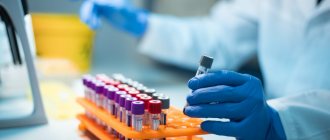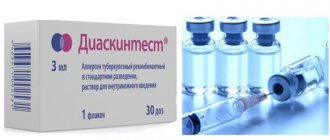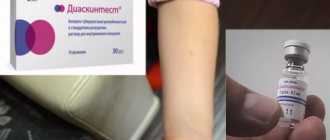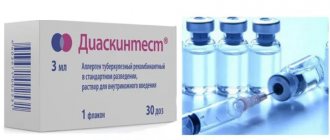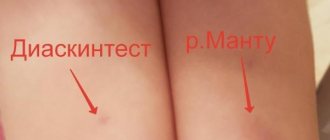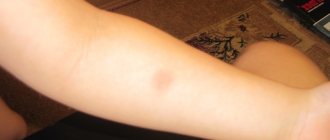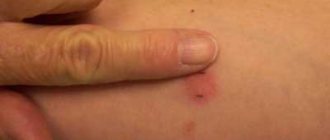Why is the sample and patient preparation needed?
Diaskintest causes redness either immediately or on the second day after the injection. Based on the reaction, the doctor will be able to judge the result. The test is considered an innovative screening method for diagnosing tuberculosis. Doctors and patients have already been able to appreciate the new way of identifying an insidious disease.
Mantoux type screening is carried out. Like this injection, Diaskintest cannot be wetted, scratched, heated, or overcooled for three days. Unlike the old method, the new one is the safest and most accurate for humans. Its results are considered the most truthful, allergic reactions and individual intolerances are minimized.
This technique cannot be prescribed to children under one year of age; it can be used to control the disease in schoolchildren and adult patients.
How does the test work?
- A person is given an injection under the skin, that is, a recombined protein, which is obtained by modifying the DNA of pathogens.
- When this protein enters the body, it causes a certain reaction, similar to an allergic one.
- If the body has already encountered foreign tuberculosis organisms, it will begin to produce special antibodies.
- An active reaction to the test indicates whether the patient is a carrier of the disease or not.
- The operating principle is reminiscent of Mantoux. The required dose of the drug is injected into the area between the wrist and elbow. Right-handed people are given an injection in the left arm, and left-handed people - in the right, to reduce the impact on the papule.
Diagnosis of tuberculosis in children is also carried out using this technique. It is not a vaccination, but tests the reaction for the presence of protein. The Mantoux test is done annually for children from one year of age. Diaskintest is considered an additional technique if the first one does not provide comprehensive data. It is recommended to be carried out from 8 to 17 years of age every year.
The test is carried out following certain rules. If the diaskintest test is negative, it is done after two months; if the patient has had an acute infectious disease, then a month after recovery. All patients who are registered with a TB doctor are tested once every six months.
How Diaskintest works
Like the Mantoux test, Diaskintest is an immunological test that determines the presence of infection in the human body. The drug contains remnants of the vital activity of tuberculosis pathogens and components of the BCG vaccination. If the body is infected, the immune system will react to the familiar gene of the pathogen and the test will show a positive result, and the BCG vaccination will not affect the reliability of the reaction in any way.
Attention! Diaskintest does not contain the pathogenic bacteria themselves, which means that it is impossible for a healthy person to get sick through the test.
Why does redness occur?
An allergy to the Mantoux test can be a direct indication for diaskintest. Within a few hours after the injection, the color of the skin changes. At first it is pale red and then acquires a bluish tint. There is no need to worry in this case. However, the occurrence of swelling and compaction should alert you.
Subcutaneous hemorrhage may be the result of an incorrectly administered injection if a blood vessel is hit. Diaskintest is an excellent prevention of tuberculosis in childhood. It can be considered as such, since the technique allows you to detect the disease in the early stages, continue to monitor it, and also prescribe adequate treatment.
Symptoms that indicate an allergy to the sample:
- at the injection site, a rash appears, a red spot, one or several, which can spread throughout the entire arm, moving to the face and body;
- discomfort, severe itching occurs;
- hyperemia of the papule;
- body temperature rises;
- in advanced cases - shortness of breath, rhinitis, swelling of the mucous membranes of the eyes, severe cough.
If an allergic reaction occurs, an antihistamine must be administered. The result is also influenced by the presence of parasites in the body. In this case, the test gives a positive result, and the immune system fails. The results can be judged on the second day of drug administration. In case of a negative reaction, only a trace of the injection remains on the skin without redness, swelling or other unpleasant symptoms.
Mantoux test and Diaskintest: what is the difference
The main difference between the Mantoux test and Diaskintest is that when examining for tuberculosis, Diaskintest NEVER gives a false positive result (a result when there is actually no infection, but the test is still positive).
If the Mantoux test may erroneously show the presence of infection after BCG vaccination or in a person who has had tuberculosis, then Diaskintest will indicate a positive result only if tuberculosis pathogens are already present in the body. Advantages of Diaskintest:
- Detection of infection in a latent form or in the early stages of disease development;
- Higher accuracy of primary diagnosis;
- The opportunity to conduct an additional clarifying examination if the Mantoux test shows a positive result.
- It is possible to monitor the effectiveness of treatment.
Types of reactions
Diaskintest results will be reliable within a few days after the injection. They are interpreted by a TB doctor. Any conclusions are drawn depending on the detected reaction. There are only three main types: negative, doubtful and positive.
A negative type means that the patient has no reaction after administration of the drug, and the skin color at the injection site has changed slightly by two millimeters. In case of a questionable reaction, there is redness or bruising, but no swelling. If the reaction is positive, the skin around the injection turns red and swelling forms.
What else do you need to know about the type of reactions to this test?
- Under normal conditions, there are no red spots or swelling at the injection site. Only a trace remains on the skin; a bruise of up to two mm and a thickening of no more than 1 centimeter are allowed.
- A swelling, papule, or bruise that appears at the injection site is a reason to conduct an additional examination of the patient. This may indicate both tuberculosis and an incorrect injection.
- Diaskintest results are assessed three days after the procedure. Often the reaction is already noticeable on the first and second days, and gradually disappears on the third.
- If the result is doubtful, then after two months additional studies are carried out and tests are taken from the patient.
- A positive reaction is always accompanied by verification of the results obtained. If tuberculosis is confirmed, the patient is registered and the form of the disease is determined. However, there are situations when the test turns out to be erroneous.
Signs of a positive diaskintest are a papule that exceeds a diameter of 2 mm. A weak reaction is characterized by a nodule size of 0.5 cm, a moderate reaction is 9 mm, a pronounced reaction is 1 cm, a pronounced reaction is a swelling area of more than 1.5 cm. If headaches occur after the injection, the temperature rises, severe malaise appears, including including nausea and vomiting, you should immediately report this to your doctor.
What to do if the sample itches?
A mild allergic reaction after an injection should not worry the patient. If your hand itches unbearably, severe itching occurs, the skin becomes covered with red spots, or the spot increases several hours after administration of the drug, you should be wary. This applies especially to children.
Doctors prohibit patients from scratching the injection site. In this case, the result will be interpreted incorrectly. Physical impact on Diaskintest provokes a change in a negative reaction to a positive one and vice versa. It is not recommended to take antihistamines within three days after the test.
Experts remind you what you should know about Diaskintest:
- Do not wet the injection site, wash it with soap, gel, or rub it with a washcloth;
- scratch it, even if severe itching occurs (this reaction is a deviation from the norm, tell your doctor about this);
- the test sometimes manifests itself only seven or ten days after it is carried out;
- if a person suffers from allergies, he should choose other methods for determining tuberculosis;
- a red mark after an injection may mean that the injection was given incorrectly, or indicate a pathology, especially if the redness does not subside for a long time;
- it is forbidden to mask redness with cosmetics, lubricate with ointments and medications that reduce inflammation (they can only be prescribed by a doctor);
- It is allowed to bandage the injection site with a bandage to minimize the impact on it.
If the sample itches unbearably, you can wipe the skin with a weak soda solution and apply a cool compress. If it is extremely important to obtain reliable results, you cannot influence Diaskintest. A few hours or the next day after the injection, spots appeared all over the body and weakness? In this case, call an ambulance immediately.
How are the results assessed?
As a rule, the reaction occurs within 24 hours. After this time, it intensifies, and after five days it disappears. It is not recommended to evaluate the result on the first day. The best option for interpreting the result is three days.
Often patients complain that redness occurs on the first day or on the second day. You can’t ignore such a reaction, but you shouldn’t worry too much. After the examination, the doctor determines the injection site and makes a preliminary conclusion. The reaction can be negative, false positive and positive.
A TB doctor evaluates the results. What is normal and pathological?
- Absence of any reactions, slight change in skin color and thickening that does not cause discomfort.
- Extensive hematoma, severe swelling, bluish skin - all this requires additional examination of the patient.
- If the doctor doubts the results, repeat the Diaskintest over time.
- Measure the redness (papule) using a ruler. A positive reaction is indicated by a pronounced (10 mm) and strongly pronounced papule (15 mm). There is severe redness, swelling, and convexity of the injection point.
- An experienced doctor will be able to determine a positive reaction simply by looking at the sample. The same applies to questionable and negative results.
In any case, Diaskintest is not an exhaustive method for determining tuberculosis. Any results require confirmation. For example, an overly positive result is a hyperergic reaction to the test. This means that the patient’s body reacted too strongly to the administered drug. This reaction is not limited to the appearance of a red spot at the injection site, hematoma and swelling. Often the papule is larger than one centimeter in size, and there is inflammation around it.
Diaskintest is carried out only by a doctor or an experienced nurse who is authorized to carry out such a procedure. Sometimes the test causes a severe allergic reaction in the patient. This is not a side effect, since the drug contains a protein that is foreign to the body. Before administering it, it is advisable to make sure that the person is not sensitive to the components of Diaskintest.
Contraindications
Diaskintest is contraindicated:
- During current or recent infectious diseases;
- During the period of exacerbation of allergic reactions;
- If you have skin diseases;
- For epilepsy.
Indications for Diaskintest
Diaskintest is prescribed:
- If you suspect tuberculosis;
- To clarify the truth of a false positive Mantoux test result;
- Persons who have had tuberculosis, to confirm the effectiveness of treatment;
- Persons who have been in contact with a carrier of tuberculosis infection;
- Persons included in the social risk group.
You can also undergo Diaskintest at your own request as part of a routine preventive examination. Tuberculosis infection exists for a long time in a latent form, without manifesting itself in the form of symptoms or complaints, so a person does not even realize that he is infected. Diaskintest, as the most advanced and effective method for diagnosing tuberculosis, will help to identify diseases at an early stage and start treatment on time.
